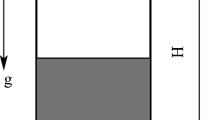Abstract
An improved stochastic separated flow (ISSF) model developed by the present authors is tested in gas-particle flows behind a backward-facing step, in this paper. The gas phase of air and the particle phase of 150 μm glass and 70 μm copper spheres are numerically simulated using the k–ɛ model and the ISSF model, respectively. The predicted mean streamwise velocities as well as streamwise and transverse fluctuating velocities of both phases agree well with experimental data reported by Fessler. The reattachment length of 7.6H matches well with the experimental value of 7.4H. Distributions of particle number density are also given and found to be in good agreement with the experiment. The sensitivity of the predicted results to the number of calculation particles is studied and the improved model is shown to require much less calculation particles and less computing time for obtaining reasonable results as compared with the traditional stochastic separated flow model. It is concluded that the ISSF model can be used successfully in the prediction of backward-facing step gas-particle flows, which is characterised by having recirculating regions and anisotropic fluctuating velocities.
Similar content being viewed by others
Author information
Authors and Affiliations
Additional information
Received 20 June 2000
Rights and permissions
About this article
Cite this article
Chan, C., Zhang, H. & Lau, K. Numerical simulation of gas-particle flows behind a backward-facing step using an improved stochastic separated flow model. Computational Mechanics 27, 412–417 (2001). https://doi.org/10.1007/s004660100253
Issue Date:
DOI: https://doi.org/10.1007/s004660100253




